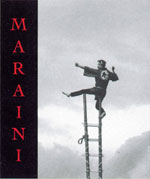on the trail of Fosco Maraini

And along cameÖTraveller, photographer, poet, visionary - as someone once said in a different context - And God Created Fosco Maraini.
An intriguing local sight, which sparked some connections as I passed it, is a small bunker-like feature just off the Old High Street in Stevenage, pictured on the left, with GRIT emblazoned in large letters. Grit, a word more commonly appropriated in a John Wayne tall-in-the-saddle way, a byword for glossy magazine revelations of personal courage conquering terminal disease. True grit. Each word with four letters, a neat parcel of two-fingered rectitude. Yet it doesnít do justice to the, well, grittiness, of the word. Grit as that bulging, snub-nosed bunker, salty and difficult to shake off. Gritting, applying grit, that crumbly irritant that is the scourge of intractable snow and ice.
Fosco Maraini knew all about grit, in every sense of the word, and having explored remote territories and mountainous terrain he could tell you in words and pictures what it means to a European and to an Asian. For in Mandarin the word grit has no precise equivalent but the closest ideogram features a word picture rather like a climber scaling a difficult angle, a vortex of whirling energy.
There is a similar sense of mapping emotion through shapes in Marainiís photography, a generous cross-section of which is presented in ĎMaraini: Acts of Photography, Acts of Loveí. This handsome coffee-table volume produced by the great 5 Continents Editions features text in English, Italian and Japanese and very well reproduced black and white images which throw into relief Marainiís lifelong fascination with the encounter between East and West. The title of his first book was Secret Tibet and, like the best travel writers (eg Norman Lewis ĎThe Honourable Societyí), he unravels the secret fascination at the margins of any social group, so that his amazing photographs of 1940ís Southern Italy reveal more about a secret society in transition than a hundred cod Coppola Mafia films.
The secrets embedded in the photographs of a vanished primitive Italian civilization are compared and interweaved with those of the Europeansí counterparts in far-flung Tibet or offshore Japan. The difference in scope is immense between Marainiís visions and the standard TV tie-in of a Michael Palin jaunt through the Himalayas, the Victorian Cambridge don abroad at the centre of a Jules Verne balloon of protected egos. For Maraini lived the dream, and when the dream became horrendous reality he stuck to his guns ≠ imprisoned in a Japanese prisoner of war camp and goaded by commandants as a spaghetti-eating motherís boy, he promptly chopped off his fore-finger in stony defiance.

Secret Tibet also shows us a nation captured through a strange refractive lens. Can these images and words be said to evoke truth or something somewhat grander? Unvarnished, undecorated snapshots of a time which was lived through and discarded or razed away. It is to nomadic trespassers such as Fosco that we owe a sense of place and culture which has been erased or censored by competing factors. A Photograph of the Deceased in a peasantís hands, a set of volumes from a Tibetan monastery library, as evocative as a scratchy 78still captures the spirit of Buddy Boldenís trumpet in a bygone New Orleans.
The spoils of victory - Marainiís work and art present us with the remnants of something which once was, both a rush of celebration and a melancholic absorption in the process of passing. Fragments of a collective memory which testify to punctured moments of beauty - Barthes in Camera Obscura writes about the punctum, the point where perception and reality collide in a traumatic recognition of the finite moment. For these punches or points in a previously uncharted line, we are to remain grateful to Maraini and those responsible for keeping his secret flame alive.
© 2005 Marino Guida